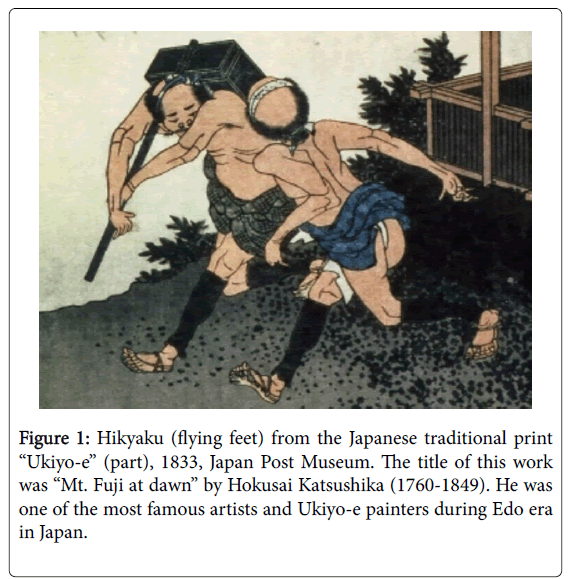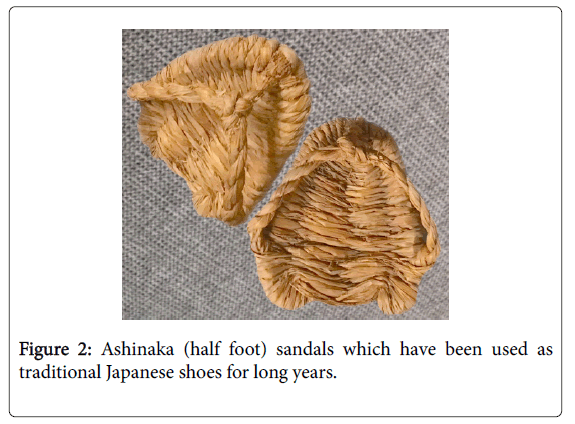Previous Wisdom Becomes Reference for Body Movements Leading to the Olympics
Received: 09-Apr-2019 / Accepted Date: 10-Apr-2019 / Published Date: 17-Apr-2019 DOI: 10.4172/2165-7025.1000e154
Keywords: Ashinaka (Half foot); Hikyaku (Flying feet)
Abbreviation
IOC: International Olympic Committee; Tokyo 2020 Games: Tokyo 2020 Olympic and Paralympic games; ATA: Anterior Transverse Arch; JMA: Japan Masters Athletics
Editorial
At the International Olympic Committee (IOC) session in Buenos Aires, Argentina, 2013, Tokyo was decided to be the host city of the Tokyo 2020 Olympic and Paralympic games (Tokyo 2020 Games). Prime Minister Abe showed off the charm and beneficial points of Tokyo, and after that he has conducted the preparation of the Organizing committee of Tokyo 2020 Games [1].
These activities can contribute not only international peace and friendship, but also mutual understanding of various cultures and further promotion of sports development [2].
There are various categories in the Olympics Games, and among them, athletics is estimated to be the fundamental of sports from the historical point of view. Among many players who have been struggling the sports, only very few players can become the professionals or Olympians. The majority of them become usual sports enthusiasts, including Masters Athletes who love and enjoy athletics.
The authors have been related with the activities of the Japan Masters Athletics (JMA) so far [3]. Among them, we have advocated the importance of leaning the body forward with less muscle tension, from short to a long distance. The runner should not put power in the toes, but relax without power.
In other words, the runner does not kick, but push the ground. These runners’ hint and tips have been shown through lectures, books and English papers [4]. Currently, we have coached two runners aiming for the Paralympic Games in Tokyo, and expected their development one year later from now.
Since several centuries ago, there was “mailman” or “express messenger” [5] (Figure 1). They ran very fast and long in order to deliver the official letter. As a supplement item to this running, they have used historical sandals worn on the soles [6].
In this article, we will introduce recommended running method and related historical running supplement item.
In Japan, about 150-400 years ago, there was Edo era with long stable period politically and socially. At that time, there was specialized mailman. He put an important letter in the box on the shoulder, and ran a long distance [4]. There was the system of express carriers on a basis of relays. The mailman was called “Hikyaku” which means Hi (flying) + Kyaku (feet).
The command was achieved by two men (Figure 1). One man has a small letter box with an official label on it and another man with a paper lantern inscribed with official business [4]. The latter person was also running swiftly along the road and the people would stand aside at their approach. By this system, the journey from Edo (Tokyo) to Osaka (570 km) was 96 hours. The time to Kyoto was only 40-60 hours by the fastest runners [4].
Similar to the shoes nowadays, they had used Ashinaka (half foot) sandals greatly. It means that Ashi (foot) + Naka (half, center, inside), and it covered the front half of the sole (Figure 2). Ashinaka has a thong in the center of the front. This is to fix by pinching between the first and second fingers. The toes are usually floating or sometimes touching the ground. The front half of the foot is cushioned to receive weight on the Anterior Transverse Arch (ATA) [7]. The material is made of rice straw, and then it helps to turn the foot inward at this point when running. In contrast, the heels are in contact with the ground so as to prevent slippery [8,9].
What is the characteristic point? When the first and second foot toes pinch the thong, the both toes can become dorsiflexion. This situation suggests that there would be no kick motion or no extension of the ankle [10]. The body can be preceded by the pushing the entire sole and heel. Consequently, the center of the gravity is smoothly moved forward while maintaining the deep forward inclination [11].
A similar movement is found in the carrying foot forward during “Sumo” wrestling game. Do not keep tension in the toes, but make pinching the thong. Then, the toes will be slightly floating and be slightly dorsiflexed.
Besides, similar phenomena would be found in Japanese old martial arts “Kendo”. If the player kicks with force on the toes of the foot, he cannot move forward rapidly. If the big toe is relaxed without muscle tension and slightly floating, the body can be leaned forward and move quickly.
As a matter of fact, the wisdom of the past becomes a great reference for modern sports and body movements. For training of moving faster, Ashinaka have been useful and beneficial. Valuable tips are: i) Do not kick the toe, ii) Push with the heel, iii) Front half of the sole is slightly turned inwards, iv) Make the body leaning forward, and v) All these factors would give each subject better running form [12,13].
In summary, Japan holds the Olympics in 2020 with continuous various preparations. On the other hand, Japan has a long history and there are two-axis walking and running methods derived from old martial arts. Ashinaka (half foot) sandals have been used for years, which are useful supplement for improving running. Various developments can be expected in the future.
References
- Keaney LC, Kilding AE, Merien F, Dulson DK (2019) Keeping Athletes Healthy at the 2020 Tokyo Summer Games: Considerations and Illness Prevention Strategies. Front Physiol.
- Ichii Y (2019) “Creative Reconstruction†and the 2020 Tokyo Olympic Games: How Does the 2020 Tokyo Olympic Games Influence Japan's Neoliberal Social Reform? Int J Jap Sociol 28: 96-109.
- Bando H, Murakami M (2019) Arches and Points in the Foot of Running Athletes. J Nov Physiother 9: 405.
- Moriyasu A, Bando H, Akayama R, Wakimoto K, Dakeshita T, et al. (2017) Thorax Flexibility can be Increased by Standing Pole Exercise. Int J Phys Med Rehabil 6: 444.
- Koda S, Smith NS (Ed.) (1937) Chapter 3. Communication. Materials on Japanese social and economic history. Tokugawa, Japan.
- Murakami M, Bando H (2018) Crucial point of how to run in the seminar and workshop in 2017 –tips for natural way of running without injury. Investigation of masters’ athletes. Annual report of Japan Masters’ Athletics Association 36: 21-22.
- Reenalda J, Maartens E, Buurke JH, Gruber AH (2018) Kinematics and shock attenuation during a prolonged run on the athletic track as measured with Inertial Magnetic Measurement Units. Gait Posture 68:155-160.
- Murakami M, Bando H (2018) Flat Grounding by Consciousness of Plantar Triangle with Decreased Impact. J Phys Med Rehabil 1: 1-3.
- Nakayama Y, Tashiro Y, Suzuki Y, KajiwaraY, Zeidan H, et al. (2018) Relationship between transverse arch height and foot muscles evaluated by ultrasound imaging device. J Phys Ther Sci 30: 630-635.
- Bando H, Murakami M (2019) The Function of Sole for Movement with Anterior Transverse Arch (ATA). Acta Scientific Orthopaedics 2: 15-17.
- Tanaka T, Suga T, Otsuka M, Misaki J, Miyake Y, et al. (2017) Relationship between the length of the forefoot bones and performance in male sprinters. Scand J Med Sci Sports 27: 1673-1680.
- Shu Y, Mei Q, Fernandez J, Li Z, Feng N, et al. (2015) Foot Morphological Difference between Habitually Shod and Unshod Runners. PLoS ONE 10: e0131385.
- Fawver B, Roper JA, Sarmento C, Hass CJ (2018) Forward leaning alters gait initiation only at extreme anterior postural positions. Hum Mov Sci 59: 1-11.
Citation: Bando H, Murakami M (2019) Previous Wisdom Becomes Reference for Body Movements Leading to the Olympics . J Nov Physiother 9: e154. DOI: 10.4172/2165-7025.1000e154
Copyright: © 2019 Bando H, et al. This is an open-access article distributed under the terms of the Creative Commons Attribution License, which permits unrestricted use, distribution, and reproduction in any medium, provided the original author and source are credited.
Share This Article
Recommended Journals
Open Access Journals
Article Tools
Article Usage
- Total views: 4208
- [From(publication date): 0-2019 - Mar 31, 2025]
- Breakdown by view type
- HTML page views: 3331
- PDF downloads: 877


